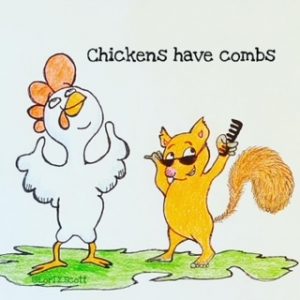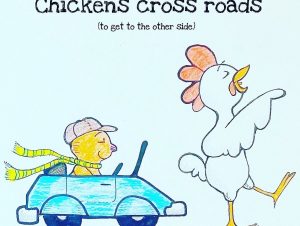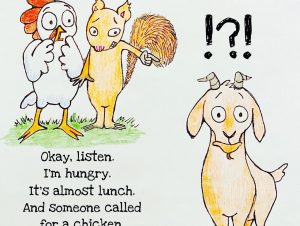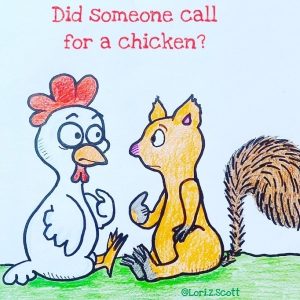Students in my second-grade classroom love reading funny books. There is a bit of science behind the attraction. Laughter increases how much air you breath in, which stimulates organs and releases endorphins that can ease tension, relieve pain, and reduce stress. Laughter also activates the release of dopamine, a brain chemical that boosts feelings of reward, motivation, and pleasure. So it’s no wonder children are draw to stories with humor. Laughter makes them feel good. That’s why often, whether it’s for a magazine or a picture book, humor sells.
If you’re not feeling funny, take heart. Humor writing can be developed by exercising your funny bone.

Word Play
A lot of humor starts with word play, a tactic often referred to as a pun. The one-liners might not get a laugh out loud reaction, but many readers appreciate their cleverness. With her popular Amelia Bedelia books, Peggy Parish wrote a whole series centered around puns.
To create these zingers, make a list of words related to your topic. Then consider the different uses for each word. Build your joke around the alternate meaning. Keep the ideas flowing and generate as many as you can, even if it’s a stretch. You can weed out the weak ones later. For example, when I had story about shoes, I considered types of shoes people might wear and generated these ideas: Plumber wear clogs. A spy wears sneakers. And doctors wear heels. I bet you could brainstorm more!

Word Choice
Face it, some words are just funnier than others. Words like snorkel, tickle, ka-pow, and chicken make me laugh every time. Sometimes you can make up funny words too. Fizzlepop. Snarkolala. Blarg. The silliness of the delivery can make it even funnier. The Book with No Pictures by B.J. Novak is a great example of this strategy. This hilarious book relies totally on silly words to make the reader laugh.
To develop this skill, keep the search bar open on your internet. (You have limited choices using the synonym feature in a Word document.) When you write a story, look for synonyms for some of your plain Jane words. Read the list out loud. Listen for the words that make you smile and either make the switch or create your own similar-sounding word. For example, substitute chortle, giggled, or guffawed for the word laughed. Or, lollyhahachucklesnort, which I just made up.

Exaggeration
The nice thing about picture books is that the pictures tell part of the story. An artist can add humor with an over-the-top illustration. Some might consider this slapstick humor since it involves a kind of physical action instead of words. A good example of this type of humor can be seen in the exaggerated character expressions in Mo Williams Elephant and Piggie illustrations. Elephant doesn’t cry. He weeps. He isn’t angry. He explodes. I believe it’s the pictures, not the text, that makes those books fly off the shelves.
But what if you’re not an artist? Outrageous comparisons can create hilarious images in the reader’s head. I’ve used word pictures like ‘an octopus in roller skates’ and a ‘crazed Doberman in bubble wrap’ to add a touch of humor.
To develop this skill, find any comparisons you write in your story. Then visualize something that captures the same emotion you’re trying to convey in the most unusual way possible by thinking–what’s crazier than that? Take it to the extreme. As before, generate as many ideas as you can and keep the best.

Crazy Foils
Warner Brother’s classic cartoon Road Runner and Wile E. Coyote builds all its humor on Coyote’s plans going awry. No matter how clever his trap, it always fails in a hilarious way. Several popular picture books use this backfire approach. Growing up, one of my favorites was Jon Stone’s Monster at the End of this Book. In it, a character named Grover doesn’t want the reader to keep turning pages. I laughed as I blew past brick walls and other obstacles Grover used to try and stop me. We see a similar give-and-take with the audience in Mo Williams Don’t Let the Pigeon Drive the Bus. No matter how much the Pigeon argues, the reader turns him down.
Writing this kind of humor is situational. Similar to slapstick humor, the author must consider not just ordinary arguments or obstacles, but outrageous ones. And the foil can’t be simple either—it has to have exaggerated responses. For Wile E., he not only falls off a cliff, an anvil lands on him. For Grover, not only does the brick wall collapse, he gets covered with concrete and mess. For Pigeon, he becomes increasingly irate.
To develop this skill, look for situations that can be turned around. For example, the child does not want to sleep. Create a list of obstacles to going to bed. Generate as many wild hurdles ideas as you can, then weed out the weaker ones. Put them in increasingly dramatic order so that the stakes get upped with every page turn. The story practically writes itself!
There are many other methods of adding humor to your story. Next month, I’ll explore a few more. In the meantime, why not try out a few if the ideas I mentioned? Remember, even if you’ve never written humor before, it can be learned. You might fall on your face a few times. But laugh it off and keep trying.

Lori Z. Scott, teacher and author, writes fiction because she’s like an atom. She makes everything up. She also has two quirky habits: chronic doodling and lame joke telling. Neither one impresses her boss, but they still somehow inspired Lori to accidentally create a ten-title bestselling children’s book series and on purpose write over 175 other publications. She continues penning stories as an excuse to not fold her laundry. Find her silly drawings, poems, and whatnot on Instagram @Lori.Z.Scott and look for her debut YA novel Inside the Ten-Foot Line coming October 2022.




No Comments